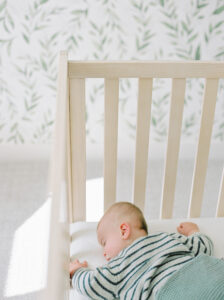In the realm of parenting practices, few topics spark as much debate as sleep training. Navigating the landscape of opinions can be overwhelming, especially when those opinions often conflict. As both a parent and a professional in the sleep field, I’ve witnessed firsthand the passionate discussions and emotional rollercoasters that unfold online, often in the form of emotionally-charged reels or evocative voice-overs.
Naturally, as sleep training has grown in awareness there are certain terms that get thrown around, sometimes inaccurately. These “buzz words” tend to spark powerful emotions in parents and can often leave them feeling confused, uncertain, discouraged, and even ashamed about their own sleep journeys.
So today it’s time to bust a huge myth in the sleep training world, and that’s the meaning behind the phrases “gentle sleep training” and “cry it out.”
But before I dive in, I want to give the disclaimer that my job is to support families who want my help and trust my expertise and process. My job is not to convince anyone that they should do something that they don’t want to do. So, if sleep training – my way or in general – isn’t for you, that’s fine!! Whatever works for your family is what you should be doing.
Decoding the Terms
I often get questions like, “are you a gentle sleep coach?” or, “do you use cry-it-out in your programs?”
Here’s the problem with these questions: the terms “gentle sleep training” and “cry-it-out” are not clinical terms.
Gentle Sleep Training
Regardless of what you may hear from “gentle” sleep coaches out there, there is not one way of sleep training that is inherently “more gentle” than another.
There are several ways to teach your child to be an independent sleeper – that is, teach them to sleep without needing to be rocked, fed, bounced, pat/shushed, etc. I talk more about the spectrum of sleep training methods here.
What “gentle sleep training” typically means to parents is that you are more physically present and involved in the process of your baby learning to sleep. But is that really gentle? Or is that just more involved?
Consider the child who is incredibly overstimulated by their parent’s presence: is staying in the room and being heavily involved actually being “gentle”? Is it actually benefitting them? Would a “gentler” method for them actually be one with less intervention?
You can see, this is where the problem lies – what is considered “gentle” for one family may be totally un-gentle for another.
The term “gentle sleep training” is meaningless.
Cry It Out
This term – “cry it out” – means many different things to different people. Your definition of cry it out may be completely different from mine.
Many families use the term to describe leaving their baby to cry for any amount of time, whether that’s 30 seconds or 30 minutes.
From my perspective – as is the perspective of most sleep consultants – true “cry it out” is synonymous with the extinction method of sleep training. This means you put your baby in their crib at 7:00 p.m. and you get them out the next morning at 7:00 a.m. with no visits in between, regardless of what happens.
The Truth About Crying
The truth is that you cannot control how much or how little your baby is going to cry during sleep training, and the amount of crying is not determined by which sleep training method you use.
I’ll repeat that: the amount of crying during sleep training is not determined by which method you use.
The only thing that is definitively determined by your chosen sleep training method is how involved you are in the process.
The goal of sleep training is for your baby to put themselves to sleep independently – that is, without your help. Whether you are picking them up and putting them back down constantly (a more hands-on sleep training method) or whether you are doing extinction and truly letting them “cry it out”, the goal is the same.
That means the only thing you are controlling is your role in the process, not your child’s emotions throughout. One baby may tolerate and even calm when being picked up and put back down over and over again where another baby might get extremely agitated by that much intervention. Same method, different reactions.
So, when people say, “I want a no-cry sleep training method” (or even worse, when sleep consultants say that they teach a “no cry sleep training method”) my answer is that’s just not realistic.
Is it possible for your baby to learn how to sleep without tears? Absolutely! There are some babies who really don’t cry much if any at all during the process. But it’s not because their parents did some magical secret “no cry” sleep training method. Crying is simply a byproduct of habit change; it’s a response to things being new + different. Going from rocking or nursing your baby to sleep to now laying them down awake is a big change in what they’re used to. It’s normal for them to have some reaction.
How to Effectively Sleep Train
In thinking about how to successfully and effectively sleep train, we need to let go of terms like “gentle sleep training” and focus instead on the things you can control. Things like:
- Your baby’s sleep schedule – when they sleep + for how long.
- Your baby’s eating schedule – when they eat + how much is offered.
- Your baby’s sleep environment – where they sleep.
- Your routines around sleep – how you prepare your baby for sleep including how you put them down.
- How you respond when they wake up.
Any good sleep training plan will have each one of these components specifically spelled out.
As you can see, sleep training is so much more than just “a method”. You can have a great sleep training method and follow it to a T, but if the other pieces of the puzzle are missing, you’re not going to be as successful. When your child is eating at the right times, going down for sleep at the right times, and sleeping in the right environment, you’re also probably going to see fewer tears than you otherwise would too.
When you’re thinking about sleep training, you want to be thinking about it from this holistic perspective. If you are looking for your own plan and support through the sleep training process, please reach out. I’d love to help!














